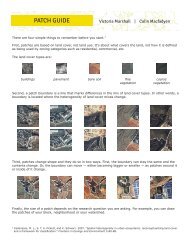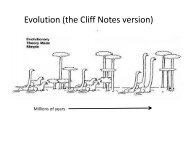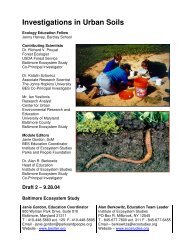BES BULLETIN - Baltimore Ecosystem Study
BES BULLETIN - Baltimore Ecosystem Study
BES BULLETIN - Baltimore Ecosystem Study
Create successful ePaper yourself
Turn your PDF publications into a flip-book with our unique Google optimized e-Paper software.
June 1998 Number 3<strong>BES</strong> <strong>BULLETIN</strong>A Monthly Newsletter of the <strong>Baltimore</strong> <strong>Ecosystem</strong> <strong>Study</strong>Institute of <strong>Ecosystem</strong> Studies ♦ Box AB (Route 44A) ♦ Millbrook, New York 12545-0129Steward T.A. Pickett, <strong>BES</strong> Project DirectorProject Director’s NoteThe <strong>Baltimore</strong> <strong>Ecosystem</strong> <strong>Study</strong> is both a scientific program and an organization. We know from some of ourcolleagues, who are studying organizations within the context of the project, that organizations can be complex.Ours is certainly complex in the number of disciplinary perspectives, agendas, institutions, financial arrangementsand cultures, among other things. Yet we are unified by common goals. These common goals are stated in theLTER proposal, which is the founding document of the <strong>Baltimore</strong> <strong>Ecosystem</strong> <strong>Study</strong>.Although many details of the research, outreach, and collaborative development are evolving as the project getsunderway, the basic intellectual framework, scientific intent, social contract, and integrative strategy are well laidout in our grant proposal. The text is on our web site, and I encourage everyone associated with the project toperuse this document occasionally. This is our constitution, and I think it reflects our best intentions and our bestcollective wisdom. We would do well to keep it in mind.EMPACT PROPOSALA proposal was prepared for the U.S. Environmental Protection Agency 1998 Environmental Monitoring for PublicAccess and Community Tracking (EMPACT) grant competition. The proposal was a collaboration of theUniversity of Maryland, <strong>Baltimore</strong> County (UMBC), the U.S. Geological Survey (USGS), Save Our Streams, andthe <strong>Baltimore</strong> Metropolitan Council. Gary Fisher (USGS) and Kristine Kuhlman (UMBC) led the proposalpreparation. The proposal received considerable support, including letters from both Maryland U.S. Senators.Unfortunately, unresolved local issues prevented submission of the proposal before the May 15 deadline.However, the proposal is still considered to be viable and is a strong contender for other funding opportunities. Itis planned that the proposal will be revised and submitted either to EMPACT internally through USEPA Region IIIor to other information initiatives, such as through NASA grants.CAPACITY BUILDING FUNDSThe Forest Service has made $60,000 in capacity building funds available to the <strong>Baltimore</strong> <strong>Ecosystem</strong> <strong>Study</strong>. Atotal of $40,000 has been equally apportioned between soil and telephone surveys, with the remaining one-thirdallocated to the acquisition of office, computer, camera, and field equipment.PERMANENT PLOT PROGRESS AND POLICYMary Cadenasso and the Vegetation Working Group field crew, Jonah Smith and Helen Thompson, have beenworking to begin vegetation sampling of the permanent plots in Oregon Ridge, Leakin Park, and Hillsdale Park.Seven 40 x 40 meter plots have been surveyed and bounded with permanent markers sunk below the soilsurface. Since there is no above ground indication of plot locations, every visitor to the vegetation samplingsites must initially be escorted. Two plots at Oregon Ridge are complete and sampling on a plot at Leakin Parkwill begin soon.STAFFINGAlysia Koufos, a Marine-Estuarine Environmental Science program Masters degree candidate, has been hired toassist with <strong>BES</strong> office and field operations (especially stream sampling). Alysia is currently working on her thesis(stream ecology) under Dr. Carl Weber of the UMBC Biology Department, and she expects to graduate this1
winter. Along with her experience as a lab technician and research assistant at the University of Arizona, Alysiahas been a biologist with the planning division of the U.S. Army Corps of Engineers for five years.David Bowes-Lyons has been hired as the Social Ecology Research Assistant. David is a recent graduate fromthe Yale School of Forestry and Environmental Studies and has worked with Bill Burch extensively. His primaryresponsibilities will be the day-to-day operations of research related to the Demographic and SocioeconomicWorking Group. David will start work in the beginning of September.Zandra Huston is working as a Research Assistant to Shawn Dalton this summer. Zandra, a Masters student inPolicy Studies at Johns Hopkins University, will be focusing her efforts on organizational analysis and fieldmapping of the neighborhoods associated with our Neighborhood Initiatives.Shawn is also interviewing candidates for a "Research Experience for Undergraduates" (REU) position. Thestudent will work with Shawn and Zandra in the field as well as on their own research. The goal is to have thisperson hired by June 17, 1998.Aralola (Lola) Akinmade will be working for one year on a number of overlapping projects that all center on theorganization and analysis of census data: urban/rural index; cluster analysis; social area index; sustainabilityindicators; historic census data; spatial analysis. A recent UMBC graduate with a Bachelor's degree inGeography, Lola has worked with cluster analysis for the Rouse CorporationWork has begun on the Neighborhood Initiatives with Parks & People Foundation’s Community Forestry Program.Personnel include Patricia Pyle, Brian (Spoon) Smith, and Amanda Cunningham. In addition, the CommunityForestry program has hired Meg Taylor to work specifically on micro-enterprise activities, and Steven Johnson,a sophomore at Morgan State University, to work with Spoon primarily in East <strong>Baltimore</strong>.Also, Katherine Cooper, an Urban Resources Initiative (URI) intern, will be working with Guy Hager of the Parks& People Foundation to identify and describe how other cities have addressed the issue of abandoned housesand lots and community open space management (including businesses). Catherine is a second-year Mastersstudent at the Yale School of Forestry and Environmental Studies.ESA COMES TO BALTIMOREThe Ecological Society of America (ESA) and the American Institute of Biological Sciences (AIBS) are holdingtheir annual meetings in <strong>Baltimore</strong>, Maryland, August 2 through 6, 1998. Some of the <strong>BES</strong> activities include:August 1, SaturdayField Trip 10Field Trip 6Field Trip 5<strong>BES</strong> field trip (Morgan Grove and Wayne Zipperer)Vegetation Assemblages of Maryland (Grace Brush)Undergraduate Ecological Education (Alan Berkowitz)August 2, SundayWorkshopWorkshopWorkshopWorkshop"The New Urban Focus;”an LTER workshop organized by LTER Network, ESA, and ESA AppliedEcology Section (Rich Pouyat, Gary Fisher, and <strong>BES</strong> partner Peter Conrad, City of <strong>Baltimore</strong>)“Plant Activities for Pre-College Classrooms” (Gordon Uno and Marshall Sundberg, BotanicalSociety of America; morning only)BioQuest Workshop: “Mathematical Biology Tools for Biology Problem Solving Curricula” (JohnJungck and Marion Field Fass; morning only)“Teaching College Biology: Roles for Professional Societies” (Louise Liao, Coalition for Educationin the Life Sciences, Alan Berkowitz, ESA, Gordon Uno, AIBS; afternoon only)2
WorkshopWorkshop“Active Learning and Teaching in Introductory Science Courses: What is it? How do we assessstudent learning?” (Charlene D’Avanzo and Diane Ebert-May; all day)“An Inquiry-Based Teaching Tool for High School Biology and Environmental Science Classes”(Prassede Calabi; afternoon only)August 3, MondaySymposiumPosters"Structure and Dynamics of Ecological Science: Beyond Boundaries" (Steward Pickett andMorgan Grove)“Mapping tree cover within an urban watershed using digital ortho-photo quarter quadrangles”(Chris Daniel, Tim Foresman, and Wayne Zipperer; 10:15 a.m.)“Spatial differences in urban air temperature evaluated by remote sensing of impervious andvegetative (ESA P-5.78)” (Gordon Heisler and Yingjie Wang)Public Plenary Watershed Approach (Jackie Carrera, Peter Groffman, and Rich Pouyat)WorkshopMeeting“Using the Web to Teach Ecology” (Ken Klemow)Education Section (5:00 p.m.)August 4, TuesdaySymposiumOral PaperDiscussionWorkshopMixer andDiscussion“The Chesapeake Bay <strong>Ecosystem</strong>: Historical and Current Perspectives on Ecological Processesand Issues” (Grace Brush will give a talk on "Ecological and human health.”)“Urban forest structure and its ability to remove air pollutants and sequester carbon dioxide”(Dave Nowak)“Ecology in the Undergraduate Curriculum” (Alan Berkowitz)“Communicating Sound Science: How to be Effective with the Media” (Katie Modelgaard, Unionof Concerned Scientists; afternoon only)“Fostering Diversity in Biology;” GMAC/SEEDS Program (Rich Pouyat and Alan Berkowitz)August 5, WednesdaySymposiumSymposiumSymposiumLuncheonDiscussionPosters"Urban <strong>Ecosystem</strong>s: A New Frontier in Ecology" (Wayne Zipperer and Larry Band)“Landscape Modeling” (Organized by Alexey A. Voinov, University of Maryland Institute forEcological Economics; 8:00 a.m. - 12:15 p.m.)“New Standards and Approaches in College Biology Courses,” (Jimmy Winter and Janet Lanza,ESA)"Diversity in Biology" (Rich Pouyat and Alan Berkowitz)“Communicating With Congress” (Nadine Lymn and Rhonda Kranz, ESA)“New Ideas in Teaching Botany and Undergraduate Biology” (BSA)August 6, ThursdayField Trip 27Field trip to Capitol Hill (Rich Pouyat)3
PostersOral Papers“Ecological Education” and “Undergraduate Papers” (morning only)“Ecological Education” (afternoon only)August 7, FridayField Trip 26Urban Stream <strong>Ecosystem</strong>s (<strong>BES</strong> collaborator Susan Gresson, Ken Belt)MEETINGS2-3 June 1998 – 11 th Annual Geographic Information Systems Conference; The University Union & TheBurkshire Conference Center, Towson University, Towson, Maryland. This conference was organized byTowson’s Department of Geography and Environmental Planning, GIS Laboratory, and Office of Corporate,Executive and Extended Education. Co-sponsorship was provided by the Association of American Geographers’Middle Atlantic Division.24 June 1998 – USFS Forest Inventory and Analysis (FIA) Meeting; UMBC Technology Research CenterBuilding, <strong>Baltimore</strong>, Maryland. Since the 1950’s, the FIA has conducted state-by-state surveys of forest standswhile traditionally avoiding urban areas. Their interest in the <strong>BES</strong> project’s vegetation assessment in an urbanlandscape prompted this meeting and a site visit to Leakin Park to see oak-tulip permanent plots. The FIA group,which numbered about 15, also heard presentations by Ken Belt (general overview of the LTER program and the<strong>Baltimore</strong> <strong>Ecosystem</strong> <strong>Study</strong>), Wayne Zipperer (vegetation analysis), and Mary Cadenasso (permanent plotestablishment and vegetation sampling). Emerging from the meeting is the potential to work together next yearwhen FIA begins its State of Maryland’s survey.WORTHWHILE READINGTitle:Grassland Dynamics: Long-Term Ecological Research in Tallgrass PrairieAuthor: First in LTER Network Series, LTER Publications Committee; edited by Alan K. Knapp, John M.Briggs, David C. Hartnett, and Scott L. CollinsPublisher: Oxford University Press; New YorkYear: 1998Title:An Ecological Assessment of the United States Mid-Atlantic Region: A Landscape AtlasAuthor: K. Bruce Jones, Kurt H. Riitters, James D. Wickham, Roger D. Tankersley Jr., Robert V. O’Neill,Deborah J. Chaloud, Elizabeth R. Smith, and Anne C. NealePublisher: United States Environmental Protection Agency, Office of Research and Development;Washington, DC (EPA/600/R-97/130)Year: 19974






